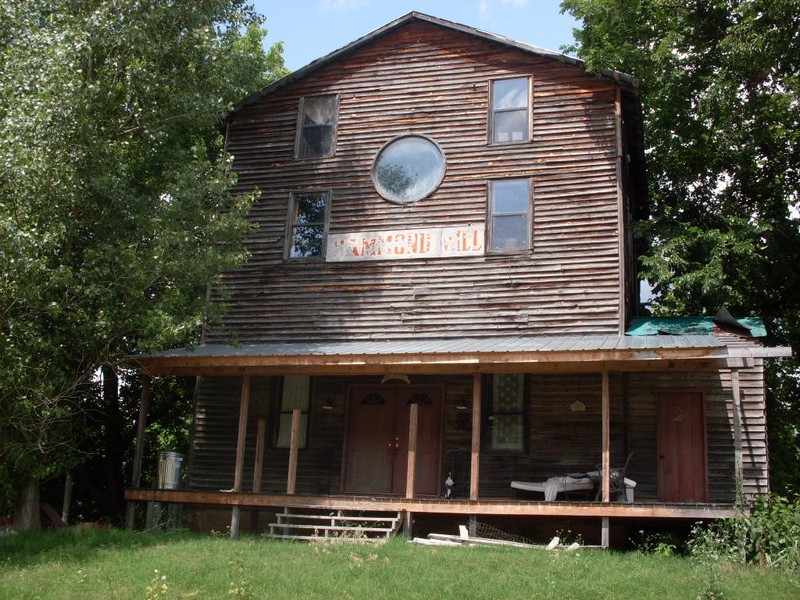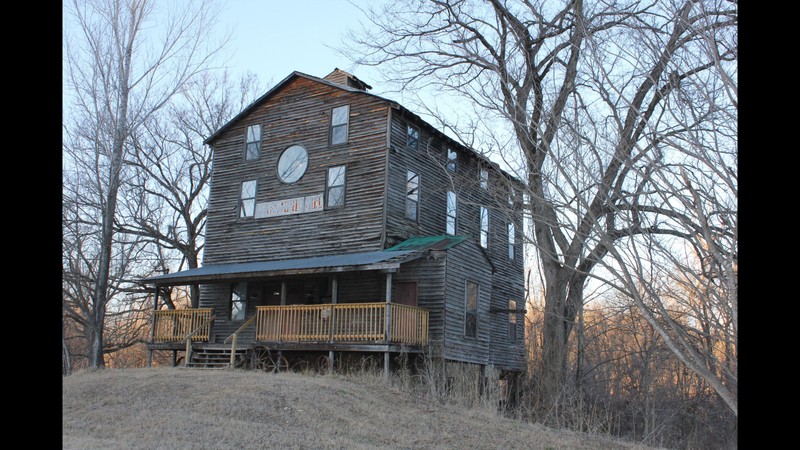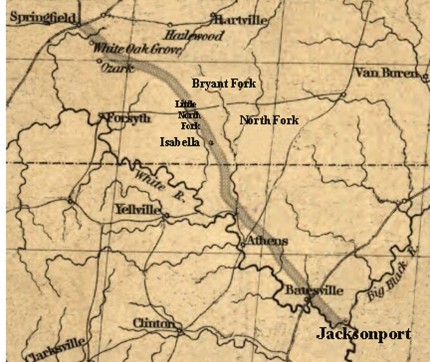Historic Hammond Mill near Thornfield, Missouri
Introduction
Text-to-speech Audio
This recently restored mill dates back to its construction in 1907. John W. Grudier, one of the founders of the now-unincorporated town of Hammond, built the mill and operated it for decades until he gave it to his son. The family sold the property in the 1940s and milling subsequently ceased. The town, once a busy community that supported a mill, shops, a bank, distiller and post office has largely disappeared, and the stream where the mill once sat has since moved further from the property. As well, the mill sat near "The Old Salt Road," a highway used before and during the Civil War for, among other things, transporting salt. So, while the community, road, and even environment are no more, the historic Hammond Mill survives.
Images
Hammond Mill in Ozark County, Missouri

Hammond Mill in Ozark County, Missouri

Map of The Old Salt Road

Backstory and Context
Text-to-speech Audio
White settlement of the Ozarks came slowly after the 1803 Louisana Purchase and more steadily after the War of 1812, when the U.S. government actively made lands in this region available for settlement. The daunting nature of overland travel through the Ozark mountains and hills resulted in more people choosing to come to the southern counties of Missouri by water, but that was no easy task, either. The two primary pathways included the North Fork and Little North Fork of the White River. The first white settlers in what evolved into Ozark County traded fur or established farms, usually in isolated valley locations. Any trip through the Ozark region proved challenging, but one of the most difficult resources to obtain involved salt, used for curing meats or canning brine.
Joseph Washington McClurg, who left his law practice to work with his father-in-law as a merchant and lead miner around 1840, recognized the issue regarding salt availability. In 1842, with salt prices rising dramatically in the region, McClurg launched an ambitious project to deal with the crisis. He traveled, surveyed, and eventually carved a path through Ozark County. All told, it took McClurg several trips over a decade to fully develop what would become known as Salt Road, which crossed into modern-day Ozark County, which organized in 1841 as an expansive county before being split into three counties in 1857.
Joseph McClurg served as a colonel in the Union Army during the Civil War. Ironically, Confederate forces frequently used his Salt Road during the Civil War to attack Union forces in Missouri. In 1862, McClurg was elected to the U.S. Congress. In 1869, he became Governor of Missouri. By then, small communities arose along Salt Road, with Ozark County an attractive option. Hammond, Missouri, received its first post office in 1893 but mainly got its start as a town in 1900 when buildings arose on the little North Fork River where the Old Salt Road crossed the stream.
Stoney Williams, John Squires, and John Grudier founded the town. Squires operated the first dry goods store, which doubled as a community gathering place that hosted meetings, poetry readings, and traveling shows. Hammond also supported its own bank, with John Squires acting as its first president. The first Post Office was in Williams' home, and Jennie Squires served as the first postmistress. Williams also owned and operated a flourishing whiskey distillery, which included doing considerable business with Grudier's Hammond Mill; Grudier built the mill and the accompanying dam on the North Fork in 1907. Although the mill sat near the river, it ran via turbines instead of water power. However, people routinely fished in the mill pond in the back while waiting for their grain to get processed. Grudier operated the mill for decades before giving the business to his son George. George also ran the mill for a lengthy period, but he sold it in the 1940s and, consequently, milling ceased.
Sources
"Douglas County, Missouri Genealogy Trails: Biographies." Missouri Geneology Trail. Accessed July 26, 2022. http://genealogytrails.com/mo/douglas/bios.html.
"Hammond Mill." Ozark County Missouri Chamber of Commerce. Accessed July 26, 2022. https://www.ozarkcounty.net/hammond.
Robins, Ruby M. "Four of Ozark County's 5 Mills Preserved, One a Ragged Beggar Dying." White River Valley Historical Quarterly 3, no. 11 (1970). https://thelibrary.org/lochist/periodicals/wrv/V3/N11/Sp70b.htm.
--- --- --- "Ozark County and Gainesville Share Rich History." White River Valley Historical Quarterly 3, no. 8 (1969). https://thelibrary.org/lochist/periodicals/wrv/V3/N8/S69i.htm.
"Ozark County, Missouri." Community and Conflict: The Impact of the Civil War in the Ozarks. Accessed July 26, 2022. https://ozarkscivilwar.org/regions/ozark.
Rossiter, Phyllis. "The Mills of Ozark County: A Tour of the Past." The Ozarks Mountains Website. 1990. https://www.ozarkmtns.com/milltour/.
Sayles, Wayne G. "An Ozark Journey: The Old Salt Road" Ozark County Times (Gainesville, MO), July 21, 2019. http://www.ozarkcountytimes.com/opinions-guest-blogs/ozark-journey-old-salt-road-0.
Wallace, Dean. "Hammond, Missouri." White River Valley Historical Quarterly 5, no. 7 (1975). https://thelibrary.org/lochist/periodicals/wrv/V5/n7/sp75e.html.
By Vsmith - Own work, CC BY-SA 3.0, https://commons.wikimedia.org/w/index.php?curid=33677312
Land and Farm: https://www.landandfarm.com/property/5_Acres_in_Ozark_County-10860462/
Ozark County Times. 2022 Article. http://www.ozarkcountytimes.com/opinions-guest-blogs/ozark-journey-old-salt-road-0
